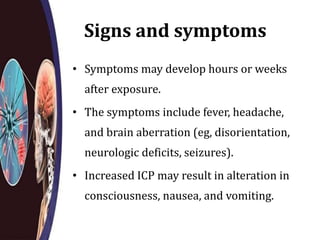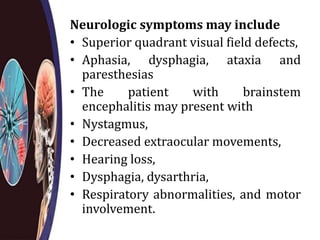Encephalitis
- 1. ENCEPHALITIS
- 2. • Encephalitis is an inflammation of cerebral tissue, typically accompanied by meningeal inflammation. • Meningoencephalitis is most commonly caused by a viral infection. Like meningitis, encephalitis can be infectious or noninfectious and acute, subacute, or chronic
- 3. Definition • Encephalitis is an acute inflammation of the brain. Most often caused by virus , although it can caused by bacteria • Encephalitis with meningitis is known as meningoencephalitIs
- 4. Types Primary encephalitis • The brain or spinal cord is the predominate foci of the toxin or pathogen. Secondary encephalitis: • It is caused by an infection that is spread from another part of the body. Viral • Resolves without specific treatment within two weeks it is also called as aseptic meningitis • Eg : Herpes simplex virus • Arboviruses Bacterial • Quite severe and may results brain damage, hearing loss, learning disability and also causes death. Fungal • It is much less common than the other two infections. It is rare in healthy people but it is more likely in persons who have impaired immune system.
- 5. Post ischemic inflammatory encephalitis: • It occurs due to brain inflammation following a CVA. In patients with cerebral ischemia, inflammation can result in secondary brain injury, and microvascular occlusion can be caused by activated leukocytes or a microvascular thrombus. This edema can result in increased ICP and compromised cerebral perfusion. Post infectious encephalomyelitis: • It follows a viral or bacterial infectious process.
- 6. ETIOLOGY • Virus : herpes simplex virus, arboviruses • Bacteria • Fungus • Cva • Immunosuppressed • Upper respiratory infections
- 7. Pathophysiology Progressive deterioration of nerve tissue Edema and increased ICP Local necrotizing hemorrhage that becomes more generalized Inflammation in brain parenchyma and neuronal cells Microbial growth and Multiplication in the cerebral tissue Crosses the blood–brain barrier or direct entry Microbial invasion
- 8. Signs and symptoms • Symptoms may develop hours or weeks after exposure. • The symptoms include fever, headache, and brain aberration (eg, disorientation, neurologic deficits, seizures). • Increased ICP may result in alteration in consciousness, nausea, and vomiting.
- 9. • Motor weakness, such as hemiparesis, may be detected. • Increased deep tendon reflexes and extensor plantar response are noted. • Bizarre behavior and personality changes may present at onset. • Hypothalamic-pituitary involvement may result in hypothermia, diabetes insipidus, SIADH
- 10. Neurologic symptoms may include • Superior quadrant visual field defects, • Aphasia, dysphagia, ataxia and paresthesias • The patient with brainstem encephalitis may present with • Nystagmus, • Decreased extraocular movements, • Hearing loss, • Dysphagia, dysarthria, • Respiratory abnormalities, and motor involvement.
- 11. Complications • Cognitive disabilities and personality changes • Seizures • Motor deficits • Blindness
- 12. DIAGNOSIS • Lumbar puncture, with evaluation of CSF, is performed to detect leukocytosis, increased mononuclear cell pleocytosis, increased proteins, and normal or slightly lowered glucose.
- 13. Polymerase chain reaction (PCR) • Polymerase chain reaction analysis of the virus' deoxyribonucleic acid (DNA), and the detection of intrathecally produced viral antibodies, are essential in diagnosing the specific virus (eg, herpes simplex virus, cytomegalovirus).
- 14. • EEG may demonstrate slow brain wave complexes in encephalitis. • MRI differentiates post infectious encephalomyelitis from acute viral encephalitis. • Brain tissue biopsy indicates presence of infectious organisms
- 15. Medical Management • VIRAL encephalitis – Acyclovir, Ganciclovir • Antipyretics to reduce fever • Diuretics – reduce risk of cerebral edema. • Anticonvulsants • Intravenous acyclovir over 10 to 21 days is indicated for herpes simplex virus. • Mothers who have genital herpes simplex may be treated with acyclovir during the third trimester to avoid shedding the virus to their babies.
- 16. NURSING MANAGEMENT • Obtain patient history of recent infection, animal exposure, tick or mosquito bite, recent travel, exposure to ill contacts. • Before delivery, women should be questioned regarding a history of congenital herpes simplex virus and examined for evidence of this virus; a cesarean delivery should be explored with the physician.
- 17. • Perform a complete clinical assessment • Monitor for increased ICP • Breathing assistance • IV fluid to enhance hydration • Preventing Injury • Promoting Cerebral Perfusion • Relieving Fever • Monitor temperature and vital signs frequently. – Administer antipyretics and other cooling measures as indicated. – Monitor fluid intake and output, and provide fluid replacement through I.V. lines as needed. • Be alert to signs of other coexisting infections, such as UTI or pneumonia • Managing Aberrations in Thought Processes • Orient to person, place, time
- 18. Nursing Diagnoses • Ineffective Tissue Perfusion (cerebral) related to disease process • Hyperthermia related to infectious process • Disturbed Thought Processes due to personality changes • Risk of Infection related to transmittal. • Risk for Injury related to seizures and cerebral edema



















